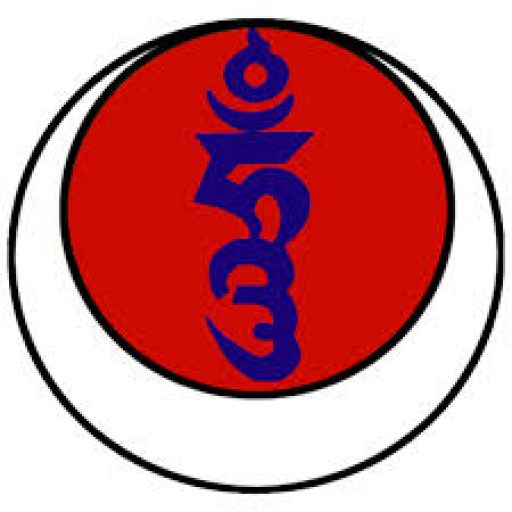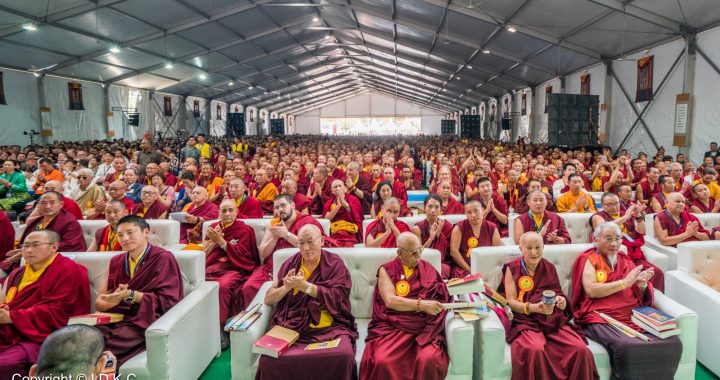By Mrs. Nyamgyal Taklha 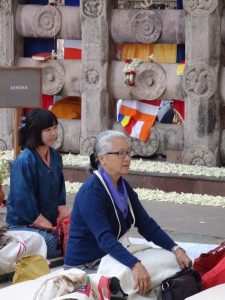
What was life for a nun in Tibet before 1959? I interviewed a few elderly nuns from Tibet. Life of nuns in Tibet was spent cleaning their simple rooms, preparing their meals, making prostrations, memorizing prayers, and praying.
Nyung-ney, a fasting and prostration retreat introduced in the 11th century by Gelongma Palmo, an Indian nun from Oddiyana, was a popular activity and taken by many nuns in conjunction with Chenresig or Buddha of Compassion (Avaloketeshvara) practice. The retreat involves fasting and multiple daily sessions of prostration and recitation of the six-syllable mantra OM MANI PADME HUNG. This is an intensive spiritual practice to purify obscurities and negativities and accumulate merit. The practice involves taking only one vegetarian meal and water the first day. The next day no food or water is taken and it goes on. There was no special Dharma classes or Tibetan language classes for the nuns. They were lucky if a literate nun would give them lessons in reading and writing.
Many nuns were admitted into a nunnery by their parents when they were very young, although a few older ones did join a nunnery on their own wishes. Parents of young nuns would sometimes offer their daughters or wards as disciples to an older nun. If there were many daughters in a family, one or two would be sent to join a nunnery. If one was physically or mentally challenged, her hair would be shaven, she would be made to wear maroon robes and yellow blouses and be identified as a nun and kept at home.
When girls or older women joined a nunnery, they had to build their own living quarters or live with another nun and get their own provisions for their daily meals. They did not receive support from the nunnery except for butter tea in the mornings, served during the prayer assembly. On special holy days, sponsors may offer tea and meals as well as some monetary offering. Poorer nuns did much of the work in the common kitchen, looked after the sheep, dri (female yak) and dzo (cross between a yak and a cow known for their excellent milk), and cows belonging to the nunnery. They took the animals to higher places for grazing, brought them back in the evening, and milked them. The nuns fetched water for the common kitchen, which could be quite a distance in some cases. They collected firewood or dried animal dung for the kitchen and they would be given some tsampa, tea, and maybe some butter. Many nuns coming from far places such as from Jangthang (nomad region) and from Kham faced difficulties feeding
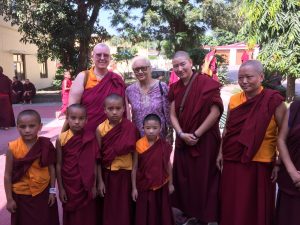 themselves. They were lucky if they had relatives in Lhasa who would supply them with their needs. If not, there were some nuns from aristocratic and well-to-do business families in the nunnery who kept the poorer nuns to do the cleaning, washing, and cooking for them while they fed them, gave them clothing, and some pocket money too. They treated them like maidservants, but some were also kind to teach them to read and write.
themselves. They were lucky if they had relatives in Lhasa who would supply them with their needs. If not, there were some nuns from aristocratic and well-to-do business families in the nunnery who kept the poorer nuns to do the cleaning, washing, and cooking for them while they fed them, gave them clothing, and some pocket money too. They treated them like maidservants, but some were also kind to teach them to read and write.
Generally Lamas and monks managed the nunneries, and a senior nun would be chosen to represent the monk. She would look after the day-to-day affairs of the nunnery. This nun would not take any decision without consulting the Lama or the monk-in-charge. I learnt from a nun in Gari Gonpa near Lhasa, that when a nun wanted to take a long leave, she had to send an application to the Khenpo or Rinpoche in charge. After the application was approved with a seal, a local oracle the nuns considered very important was requested to go into trance to re-approve the leave.
The nuns did not have classes for language or dharma studies in the Nunnery. The younger nuns would be lucky if they were under the supervision of a senior nun who would teach them to read and write. The emphasis was on memorization of prayers, which they had to recite at the daily prayer assemblies. If there was a public Teaching in Lhasa or nearby, they could go and attend, but this was not often. Lack of education and financial support, low self esteem, trying to be humble, and the nuns’ hesitance to break out of their closed selves were major obstruction to advancement and their recognition in society.
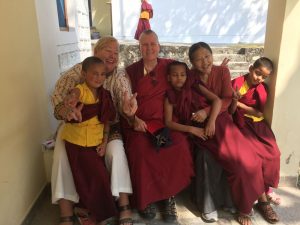 In Tibet and other Himalayan Buddhist regions, it was the custom for girls to be quiet, obedient, and submissive. Being humble was a message put in the mind of most women, especially nuns. These qualities were embedded in them. I was very talkative and mischievous when I was young, and my nanny used to say, “If you are so naughty and talkative, you will not find a husband.” The role model for girls was to find a good husband.
In Tibet and other Himalayan Buddhist regions, it was the custom for girls to be quiet, obedient, and submissive. Being humble was a message put in the mind of most women, especially nuns. These qualities were embedded in them. I was very talkative and mischievous when I was young, and my nanny used to say, “If you are so naughty and talkative, you will not find a husband.” The role model for girls was to find a good husband.
In Ladakh or maybe even in other Himalayan regions, one daughter was made a nun and she was kept at home to do all the manual work in the house. An educated nun from Ladakh told me that nuns were actually family slaves til things changed about a decade back. Another nun, who was a pioneer in opening a modern nunnery in Leh, Ladakh, faced much opposition and non-cooperation from the community, but the nuns in this nunnery are receiving good education, a few are traditional physicians; they take care of the sick and the needy, and they also assist with family problems.
On 19th September 2004, I became the Director of Drikung Kagyu Samtenling Nunnery at Dehra Dun. I was requested to look after the nuns by my brother, His Holiness Drikung Chetsang Rinpoche. A few young monk staff members and some nuns at the nunnery also asked me to come and take charge of the nunnery administration. I took up the job without a salary and on voluntary basis. A senior monk was in charge of the Nunnery, and they thought a woman would be a better administrator. My first job there was to make a rule that no monk or man could visit a nun in her room. They could always visit them, but they must meet in the common room or out in the garden. Education was a priority and modern education was very important for the nuns, so was getting some exercise and healthy nutrition. Most important was for the nuns to administer their own nunnery.
The nuns were studying Tibetan language and dharma, but they needed more general knowledge and to learn to read, write, and speak English and Hindi. They also needed to know simple calculation. One day, I took a couple of the older nuns from Tibet to the hospital, and on the way they wanted to buy some fruits. They could not add up the cost and I had to help them.
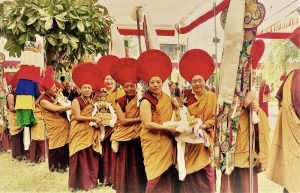
The nuns were encouraged to have debating classes. At first, a couple of the senior monks thought this was not done by nuns and they were discouraging, but we continued and now the nuns are debating and doing well.
The nuns needed to express themselves and answer questions instead of keeping their heads down and not uttering a word. When I asked a few nuns their names, they would look down, giggle, and say their names so softly that one could hardly hear them. This was terrible. I told them, “Why are you not looking up at my face and tell me your names with a louder voice?” There was no response.
After I settled down to work, I requested the nuns to vote a senior nun to become Asst. Director. Workshops were organized for the nuns on empowerment and public speaking. We also invited nuns from other nunneries of different Tibetan Buddhist Schools, and the Chief Guests were all nuns. Our first guest was H.E. Khando Rinpoche from Mindoling Monastery. We had Jetsun Tenzin Palmo from Drukpa Kagyu Dongyu Gatsel Nunnery, Tsuenma Losang Dechen from Dolmaling Nunnery, and a Chinese nun, a Professor from Taiwan. It was important for our nuns to see that nuns can become leaders.
During important functions, it was the custom for the Heads of the Departments of Drikung Kagyu Institute to come and present the Mandala Offering to His Holiness. During one teaching, I told the Asst. Director, Tsunma Yeshi Drolma, that now she should offer the Mandala on behalf of the nuns instead of me.
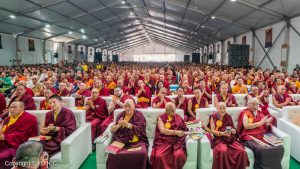 The big day came, the large hall was packed, the Heads of DKI branches slowly walked towards His Holiness’s throne and Yeshi la refused to get up. People were looking at me. I got up and went over to Yeshi la and told her to please go up to present the Mandala. She refused. I told her that in no way would I go up. Tears collected in her eyes and she would not budge. I asked the Disciplinarian, who was sitting next to her to go up and she too refused. Tsuenma Kunchok Palmo, a Msc. Graduate was nearby and she too refused to go. I went back to my seat, continued to sit there, and slowly Yeshi la got up, prostrated and went to join the small group for the Mandala Offering. When the ceremony was over, I went up to her and asked her, “Was it difficult?” She was beaming and she said, “No” and started giggling. Since then, during all ceremonies the nun Director offers the Mandala.
The big day came, the large hall was packed, the Heads of DKI branches slowly walked towards His Holiness’s throne and Yeshi la refused to get up. People were looking at me. I got up and went over to Yeshi la and told her to please go up to present the Mandala. She refused. I told her that in no way would I go up. Tears collected in her eyes and she would not budge. I asked the Disciplinarian, who was sitting next to her to go up and she too refused. Tsuenma Kunchok Palmo, a Msc. Graduate was nearby and she too refused to go. I went back to my seat, continued to sit there, and slowly Yeshi la got up, prostrated and went to join the small group for the Mandala Offering. When the ceremony was over, I went up to her and asked her, “Was it difficult?” She was beaming and she said, “No” and started giggling. Since then, during all ceremonies the nun Director offers the Mandala.
Nuns also sat at the back of the hall during Teachings. I requested His Holiness Drikung Chetsang Rinpoche, Lineage Head to let the nuns sit on one side and the monks on the other side. We had senior nuns who were well versed in the Teachings and why should they sit behind some young monks, who had just joined the monastery? He gave instructions to let the nuns sit on one side of the Prayer Hall in the temple. Initially, the nuns would not come to the front and kept sitting at the back. I had to tell them that they must now come forward. When the nuns did not come up front, the Director of the Monastery, Kusho Choenyi la came up to me and said, “We have made the seats for the nuns so that they need not sit at the back, but they refuse to come up to the front!” Now they sit in front.
We also encouraged the nuns to join workshops and conferences organized elsewhere by other nunneries or the Tibetan Women’s Association. We also encouraged teachers and visitors from abroad to come to the nunnery. Meeting and mixing with people outside one’s region is so important to open up and learn of the outside world. This also helps them to improve their English.
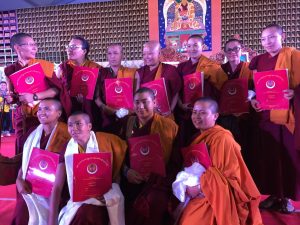
After two years, I left the post of Director and a nun was elected for the Director’s post. I continued to assist the nuns as their Advisor. Yeshe Drolma la, the first Asst. Director missed one year of studies. Thereafter, it was decided that the nuns elected to the post of Director take this duty for a year only, because they were still students.
As for my part, instead of visiting them once a week as done during the early stages of my work, I went to the nunnery, once in two or three weeks. There is a trained Accountant- cum-Secretary in the office and the nuns have done a very good job of running their nunnery now. There is still some hesitancy about being the Director.
We now have 74 nuns. We have a computer, an art class, and a class for ritual training every Sunday. On their own initiative the nuns have also founded a Publication Department. They have started a vegetable garden, and they took part in cleaning campaigns in the nearby villages.
Ten nuns wished to take up computer and English courses in Dharamsala during this summer instead of going home or spending their summer holidays elsewhere. This is a good sign that they wish to grow.
It gives me much pleasure to see the nuns maturing, growing out of their shyness, and gaining confidence and trust in themselves. Last year, two nuns graduated from the Kagyu College for monks and nuns, and obtained their Acharya degree. They went for further studies on a program at Sera College in South India. Now they returned to Kham to teach in a Kagyu Nunnery there.

Five nuns graduated this year. One nun wishes to enter the 3 years, 3 months and 3 days retreat. It will be the first time a nun who has graduated with an Acharya degree is joining our Retreat Center. Another nun, Yeshi Dolma will go to assist Khenmo Drolma in the first Drikung Nunnery in USA. Of the three others, Tsunma Kunchok Tsekyi is selected to become the first Director for a period of two years, which will be extended to three when the next election for the post takes place. The other two nuns will be teaching at the Nunnery.
My wish to see the nuns administer their own nunnery is now a reality. Thanks to our lineage Head, His Holiness Drikung Kyabgön Chetsang Rinpoche, our teachers, the staff at the Nunnery, and all who have supported us, this big step is possible. Without the leadership of His Holiness the Dalai Lama, expressing his wish for gender equality and his special concern for the education of Buddhist nuns, I doubt we would have come this far. The nuns have also been very supportive of each other. I take leave as Advisor of the Drikung Kagyu Samtenling Nunnery this August. A few senior nuns will be elected to form a Board of Advisors of the Nunnery. I wish the nuns well and I am confident that they will do a good job. 21st August 2016
After this letter, I took Acharya Kunchok Tsekyi, the new Director of DK Samtenling Nunnery with me to show her how other nunneries are run in Dharamsala. We visited Dolmaling. The Asst. Director of the Nun’s Project, Tsuenma Lobsang Dechen was very kind to take us around. We then visited Shugseb Nunnery. Due to teachings by His Holiness the Dalai Lama and my departure from Dharamsala, we could not visit more nunneries. Tsekyi had visited the Nunnery in Mcleod Ganj. I am very happy to see that Tsekyi is taking her responsibilities successfully.
She said, “During the Shravasti Teachings, I had to go along with the heads of other departments and Khenpos during some events and it was very difficult. I did it as you said and not for myself, but for the future of our Drikung nuns. I joined in all the events and I was the only female. It was not easy, but I did it.”
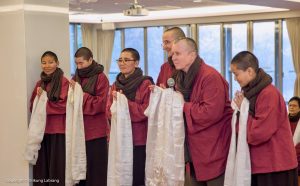
I think a nun getting the same education and position, as a monk is quite new in the Tibetan and Himalayan community. There is insecurity and disapproval from some monks. One senior monk from Tibet said, “Now the nuns are growing wings!” and it was said in a sarcastic way. But nothing is permanent and we have to change and change for the better.
December 2016
Ani Sonam, Ani Tsekyi, Ani Drolma, Ani Yeshe Metok, Khenmo Drolma, Ani Drolkar at the 2018 Shravasti Teachings
